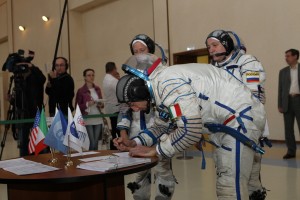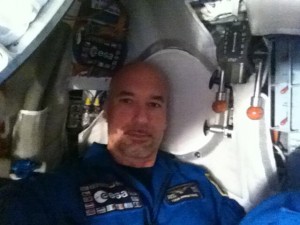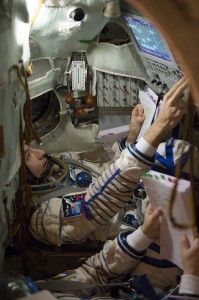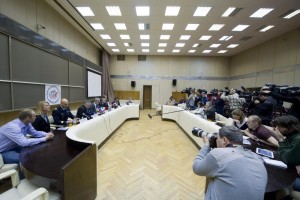 The third and final exam is the most complex. We re-enact the five key stages of a complete Soyuz flight: launch, entry into orbit, approach and docking, undocking and return to Earth. It is extremely challenging. The full commission assesses our behaviour and how we work together.
The third and final exam is the most complex. We re-enact the five key stages of a complete Soyuz flight: launch, entry into orbit, approach and docking, undocking and return to Earth. It is extremely challenging. The full commission assesses our behaviour and how we work together.
These five steps are part of a single simulation, which lasts a full day even though in reality the docking and detachment occur six months apart. We train for a long time in order to pass this exam and it requires a lot of effort. You can expect many emergencies in these exams, obviously we are not told beforehand what they will be. The failures can be obvious but sometimes they are very subtle.
The exam usually starts around 8:45 with the crew entering the simulator – the capsule. I  am the first to get in and do the initial checks and to prepare the cockpit for the other two crew members, as I will during the real launch on 28 May. I am the first to sit down, I fasten the seat belts and configure the radio to communicate with the control centre. We follow a series of checks that include checking that our suits and capsule are airtight. After about 40 minutes the countdown to the simulated launch begins. At this point we encountered our first emergency, the capsule did not detach from the rocket. We had only ten seconds to react because if the vehicle remains attached to the rocket it may end up in an incorrect orbit. We sent the order to release the capsule from the rocket manually. I have to send this command in coordination with the commander. We were very quick and responded only five seconds after having verified that the separation had not occurred.
am the first to get in and do the initial checks and to prepare the cockpit for the other two crew members, as I will during the real launch on 28 May. I am the first to sit down, I fasten the seat belts and configure the radio to communicate with the control centre. We follow a series of checks that include checking that our suits and capsule are airtight. After about 40 minutes the countdown to the simulated launch begins. At this point we encountered our first emergency, the capsule did not detach from the rocket. We had only ten seconds to react because if the vehicle remains attached to the rocket it may end up in an incorrect orbit. We sent the order to release the capsule from the rocket manually. I have to send this command in coordination with the commander. We were very quick and responded only five seconds after having verified that the separation had not occurred.
Once in orbit, we continuously verified everything was in order to be sure that the pressure in the capsule had not decreased but everything seemed to be in working order. Soon afterwards, as we were preparing to fire the capsuleengines for the first time to move from the initial orbit to the parking orbit. An initial orbit is reached after the launch and a parking orbit is an intermediate orbit between the initial orbit and the Space Station orbit, also called Low-Earth Orbit. The parking orbit allows us to ‘phase’ – to wait for the right moment to approach the Station.
Commander Fyodor noticed a failure in the infrared sensors during the parking orbit. These sensors identify the correct position of the capsule. Fyodor fixed the problem by taking manual control of the spacecraft, while I dealt with the stabilisation system control.
During the third phase of this simulation – the approach to the Station – we experienced a double failure with the rendezvous radars. This is a serious problem because all the necessary information for the capsule computer to navigate the spacecraft comes from these radars. The solution? Take manual control of the capsule! Commander Fyodor, supported by Karen and myself, handled the final approach phase, about 3 km away from the Station until we docked.
After the simulated docking we had a half-hour break to remove our suits and rest before starting the second phase: undocking the Soyuz from the International Space Station and our return to Earth.  We took our positions in the capsule once again and right away, during the initial undocking procedures, I realised that there was a gas leak in the fuel pressurisation system. Aerospace engines must maintain fuel pressure. Losing pressure can cause an ignition failure for example. As soon as I realised what was going on I raised the alarm with the ground commander. A coordinated decision was made to perform a quick-return, an ‘uncontrolled’ return through Earth’s atmosphere, also known as a ‘ballistic reentry’. This entails a higher deceleration which is not comfortable, but on the other hand, it is a much faster. The ignition of the retrorockets is started much earlier than in a normal reentry, this increases the chance that the engine will perform as it should.
We took our positions in the capsule once again and right away, during the initial undocking procedures, I realised that there was a gas leak in the fuel pressurisation system. Aerospace engines must maintain fuel pressure. Losing pressure can cause an ignition failure for example. As soon as I realised what was going on I raised the alarm with the ground commander. A coordinated decision was made to perform a quick-return, an ‘uncontrolled’ return through Earth’s atmosphere, also known as a ‘ballistic reentry’. This entails a higher deceleration which is not comfortable, but on the other hand, it is a much faster. The ignition of the retrorockets is started much earlier than in a normal reentry, this increases the chance that the engine will perform as it should.
Once we undocked from the Station, Fyodor began the procedure to start ‘Program 5’, the ballistic reentry. We soon realised there was a failure in the central computer and with very little time available we decided to override the computer and take manual control of the capsule for a third time. This is a critical stage, with very complex procedures, and Fyodor and I have to work in perfect sync: when the main computer is released, all peripherals stop working!
We reactivated manual systems and from this moment onwards, I could turn the engine on or off – an extremely important function that is managed by the flight engineer and the commander. At the scheduled time I fired the engines and began the deorbit burn, or re-entry ‘push’. This slows down the speed of the spacecraft enough to force it back into Earth’s atmosphere. While I checked the engines’ parameters, I noticed a sharp drop in the fuel supply pressure which lead to an engine failure! This is a serious issue since the only way to continue the descent is by activating the secondary engines. This would normally happen automatically if but the main computer was not working! I only had a few seconds to react and on the commander’s order I executed a series of actions to stop the main engine and then selected and activated the secondary one. The manoeuvre worked perfectly and we continued our descent.
The last failure we faced, though not as serious as the previous ones, was when the capsule separated from the service module that has the main engine: the automatic valve that sends oxygen to our suits did not open. This is my responsibility and all I needed to do was open the valve manually.
Once in Earth’s atmosphere, with the parachute already open, the Examiners Committee gave the OK. The exam had come to an end. Eight hours had gone by from the moment we entered the simulator!
READY FOR FLIGHT
Once the exam was finished Karen, Fyodor and I discussed how the exam went and what  had happened. When we all agreed on the times and failures we faced and how we resolved them, we entered the room where the examination committee was to answer their questions. They asked us what our impressions were and what we noticed during the simulation. We gave a full account of all the issues and how they were addressed. If any mistakes are made it is essential at this point to report on them. Everything went well. My adventure on Earth ended with the highest marks!
had happened. When we all agreed on the times and failures we faced and how we resolved them, we entered the room where the examination committee was to answer their questions. They asked us what our impressions were and what we noticed during the simulation. We gave a full account of all the issues and how they were addressed. If any mistakes are made it is essential at this point to report on them. Everything went well. My adventure on Earth ended with the highest marks!



Discussion: 2 comments
Ciao Luca,
grazie per questi tre articoli così dettagliati. Tutto materiale utilissimo per i miei prossimi libri. 😉
Buon lancio!
Carla
“Una volta che l’esame era finito Karen , Fyodor ed io abbiamo discusso come è andato l’esame e quello che era successo . Quando siamo stati tutti d’accordo sui tempi e gli errori che abbiamo dovuto affrontare e come li abbiamo risolti, siamo entrati nella stanza in cui era la commissione di esame per rispondere alle loro domande . Ci hanno chiesto che cosa le nostre impressioni erano e ciò che abbiamo notato durante la simulazione . Abbiamo dato un resoconto completo di tutte le questioni e di come sono state affrontate. Se vengono effettuati eventuali errori è indispensabile a questo punto riferire su di loro . Tutto è andato bene . La mia avventura sulla Terra si è conclusa con il massimo dei voti ! ”
Sorrido ripensando a quei momenti che hai vissuto, che chissà, forse a te sembrano essere accaduti un’eternità fa.
Ma grazie al tuo blog noi che non c’eravamo possiamo tornare indietro nel tempo e rivederti, felice ed eccitato, per la nuova pagina della tua avventura 🙂
Più avvincente di un best seller 😉 😀